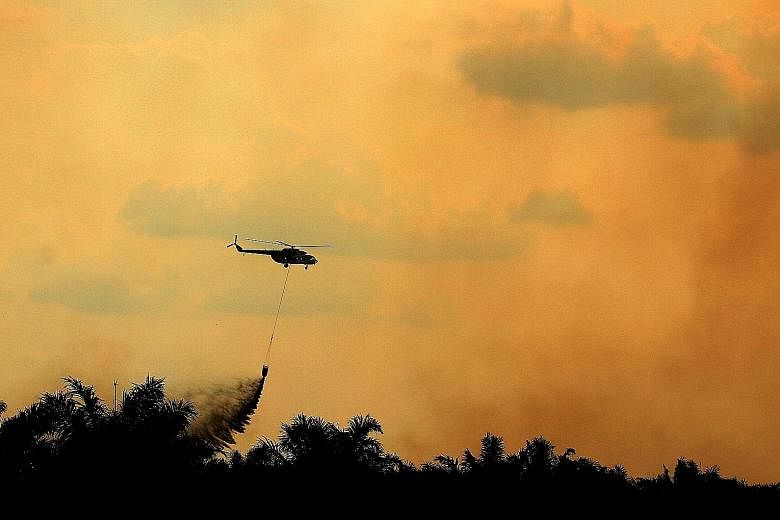The number of forest fires across Indonesia fell by more than 30 per cent this year as fire prevention and enforcement efforts, started after the transboundary haze crisis in 2015 sent air pollution to record levels, continue to bear fruit.
The 2,400 hot spots recorded thus far this year as the dry season ends are less than the 3,563 picked up by satellites run by the National Oceanic and Atmospheric Administration in the same period last year.
Similarly, hot spots detected by Terra-Aqua satellites also decreased by 47 per cent, from 3,628 last year to 1,927 this year, said Indonesia's National Disaster Management Agency (BNPB) yesterday.
The latest figures on hot spots are substantially lower than the 130,000 or more hot spots that hit Indonesia in 2015, when more than 2.6 million ha of land was razed.
The burning of forests and peatland in Kalimantan and Sumatra that same year also produced transboundary haze that blanketed the region and led to record air pollution levels across Indonesia, Malaysia and Singapore for months.
Since then, Indonesia has managed to limit the amount of land burned and prevent a repeat of the 2015 crisis.
BNPB spokesman Sutopo Purwo Nugroho said that based on satellite imagery analysis conducted by Indonesia's Ministry of Environment and Forestry, about 124,983 ha of land has been burned so far this year, which is just over a quarter of the 438,360 ha affected by fires last year.
"The peak period for the threat of forest and land fires has passed," said Dr Sutopo, referring to the months of September and October, when the dry season usually hits Indonesia.
"And thanks to the preparation, synergy and anticipation by various parties to fight forest and land fires, the number of hot spots and the extent of fires were down compared to the previous year."
The latest figures on hot spots, however, revealed a shift in the location of forest and land fires, from Kalimantan and Sumatra islands, to East Nusa Tenggara, West Nusa Tenggara and Papua, he added.
According to data from the ministry, about 33,030 ha and 26,217 ha of land in east and west Nusa Tenggara respectively, were burned, while 16,492 ha of land was similarly affected in Papua. More favourable weather also played a part in Indonesia's recent success in preventing fires, said Dr Sutopo.
"The dry season of 2017 was 'normal' and drier than in 2016, (when the drought) was shortened due to the La Nina weather phenomenon," he said. "But compared to 2015, the drought in 2017 was lower in intensity. In 2015, it was a very long and dry season due to the impact of El Nino."
El Nino refers to the climate phenomenon that causes a warming trend conducive to the burning of land, but it is usually followed by the wetter La Nina season.
The release of the figures by BNPB follows a report by Global Forest Watch (GFW), a non-governmental programme run by the World Resources Institute, which indicates that new data shows fires are getting worse around the globe and contributed to record-breaking tree cover loss last year.
"The Indonesian fires of late 2015 were a major environmental disaster, releasing 1.62 billion metric tonnes of CO2 (carbon dioxide)," said the GFW report. "The resulting haze caused over 100,000 premature deaths. Though many of the fires occurred in late 2015, most subsequent tree cover loss wasn't recorded until early 2016."
The report released on Monday also showed that global tree cover loss spiked to a record 29.7 million ha last year, or 51 per cent higher than in 2015 - roughly an area the size of New Zealand.

